Joint demonstration of J-SPARC initiated by ALE and JAXA, aimed at
the commercialization of space debris prevention device
June 5, 2020 (JST)
ALE Co., Ltd.
National Research and Development Agency
Japan Aerospace Exploration Agency
ALE Co., Ltd. (Minato-ku, Tokyo; Lena Okajima, CEO) and Japan Aerospace Exploration Agency (Headquarters: Chofu-shi, Tokyo; Hiroshi Yamakawa, President; hereinafter “JAXA”), as a project of the JAXA Space Innovation through Partnership and Co-creation (J-SPARC) initiative, are engaged in the “commercialization of space debris prevention devices that work by promptly deorbiting satellites after the completion of their mission,” as a space debris mitigation measure (*1). Having co-created the concepts of the project, the two partners have now moved on to the joint demonstration phase. In the joint demonstration phase, ALE and JAXA will collaborate toward launching their space debris prevention device aboard a nano-satellite during fiscal 2021 for demonstration in space. Following the demonstration, ALE aims to develop a business to manufacture and market the device.
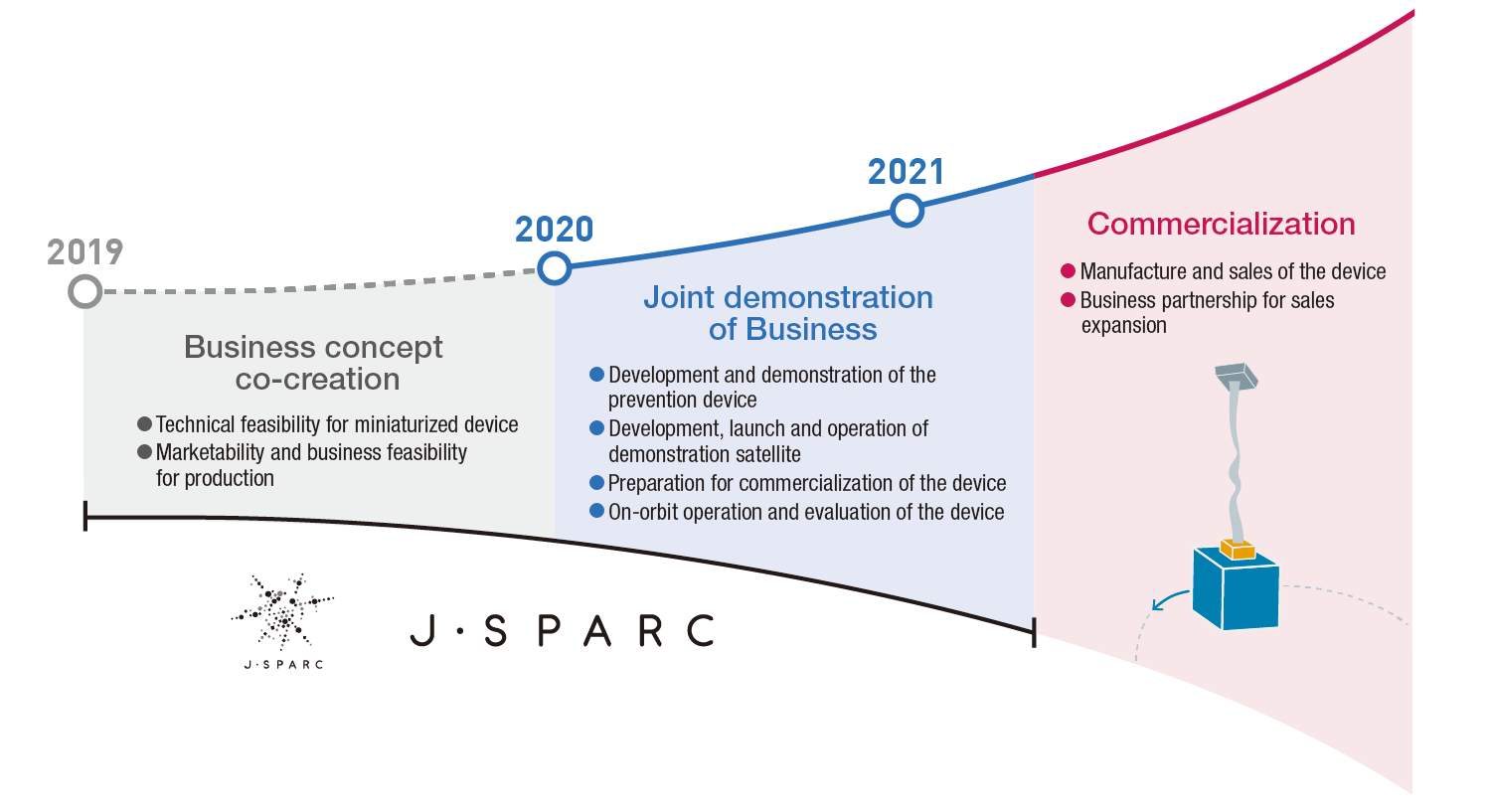
This “space debris prevention device” is the world’s first device using a carbon nanotube (CNT) cathode and an electrodynamic tether (EDT) (*2). The device is mounted onto a satellite prior to its launch. After completion of the mission, a long tether is extended into space to change the orbit of the satellite induced by the Earth’s magnetic field. By lowering the orbits of satellites within a short period of time, they will reenter the Earth’s atmosphere and burn up.
In the joint demonstration, based on the knowledge derived from the co-creation of the concepts, ALE is responsible for: developing and demonstrating the EDT devices including the CNT cathode (*3); developing, launching and operating a nano-satellite with the devices on board (*4); and preparing for the commercialization. Meanwhile, JAXA will create a prototype model for the EDT and CNT cathode, and conduct EDT orbit analysis and evaluation of on-orbit operation of the CNT cathode.

By the development of the device with this joint onboard demonstration, it will become possible to reduce the number of satellites remaining in a low Earth orbit, which is expected to increase rapidly in the future, and to thereby prevent the generation of large quantities of hazardous debris caused by collisions with other space debris. ALE and JAXA will promote this joint demonstration as one of JAXA’s initiatives to mitigate the space debris issue and contribute to sustainable space development.
[Comments from the representatives]

|
Lena Okajima, President/CEO of ALE Co., Ltd. |
|---|

|
Hiroyuki Iwamoto, Director of Business Development and Industrial Relations Department, JAXA |
|---|
(*1) International environment surrounding space debris mitigation measures:
Space debris mitigation measures that are being considered include methods to remove space debris already in orbit (ADR: Active Debris Removal) (Note 1) and methods to promptly deorbit satellites after the completion of their mission (PMD: Post Mission Disposal). The device being developed by ALE corresponds to PMD.
Actions are being taken in various countries around the world and by international organizations to impose legal obligations on businesses to implement measures to reduce space debris. Amid such a climate, there are increasing expectations for PMD.
(Note 1) At JAXA, comprehensive space debris mitigation measures are being promoted and CRD2 (Commercial Removal of Debris Demonstration) is being implemented for the realization of ADR.
Commercial Removal of Debris Demonstration:
http://www.kenkai.jaxa.jp/research/crd2/crd2.html (Japanese Only)
(*2) Carbon NanoTube (CNT) cathode and ElectroDynamic Tether (EDT) device:
EDT is a lightweight propulsion device to extend a long tether in space and change the satellite orbit using earth’s magnetic field. CNT cathode is an electron-emitting device using carbon nanotube and in combination with EDT, deorbiting may be carried out effectively and the time required in lowering the altitude may be reduced significantly. This is the world’s first PMD device used in combination with CNT cathode and EDT.
(*3) Development and demonstration of EDT device:
In developing and demonstrating this device, ALE has collaborated with Kanagawa Institute of Technology which specializes in knowledge regarding EDT behavior to conduct joint research on the mechanical behavior of long objects during EDT unfolding in orbit and during descent from orbit.
(*4) Development, launching and operation of nano-satellites:
ALE has collaborated with Tohoku University with which they already have joint achievements in satellite operation, utilizing their knowledge on the development and operation of the nano-satellite system. They will conduct joint research on the development and operation of nano-satellites with these devices mounted thereon.
[About ALE]
ALE’s mission is to “Make Space closer. For all of us. Together.” With our innovation and technology ALE strives to fulfill the endless curiosity of us humans, and to advance the development of science as well as grow space business that will enrich our daily lives.
| Company Name: | ALE Co., Ltd. |
|---|---|
| Address: | Sumitomo Fudosan Shibadaimon-NichomeBldg. 2F 2-11-8 Shibadaimon, Minato-ku, Tokyo 105-0012, Japan |
| CEO: | Lena Okajima |
| Established: | Sept. 1, 2011 |
| Business Overview: | Space Entertainment Business ”Sky Canvas”, Data Service Business, Development of Microsatellite Technologies |
Business Overview
Sky Canvas
Sky Canvas is ALE’s aerospace entertainment project, which likens the sky to a vast canvas of opportunity. The company’s first project under this banner is achieving the world’s first man-made shooting star. It plans to follow that project with development of a variety of next-generation entertainment. The aerospace entertainment segment enables ALE to convey the appeal of space and science to a wider audience in order to draw attention to those sectors and draw more talent to the field.
* “Sky Canvas” is a registered trademark of ALE
Data Service Business
Observation of man-made meteor shower and other technologies enable data measurement and information retrieval of the lower and middle atmosphere. These data relate closely to climate and can help characterize the mechanisms behind climate change. ALE plans to collaborate with scientists and research institutions to characterize extreme weather events and improve accuracy in weather forecast models.
Development of Microsatellite Technologies
ALE conducts development of micro-satellite and associated technologies. Current, ALE is working with the Japan Aerospace Exploration Agency (JAXA) to develop compact, lightweight electrodynamic tethers (EDT). This EDT is expected as one of the effective measures to counter space debris proliferation, that Japan has set as a priority. By installing this EDT in advance on the satellites and rockets that will be launched in the future, it will be possible to lower their orbit after the mission and make them enter Earth's atmosphere. This type of post-mission disposal (PMD) technique will prevent the generation of new space debris.
* ALE press release on conductive tether (EDT)
* JAXA press release regarding tie-up with ALE (J-SPARC) in EDT development
http://aerospacebiz.jaxa.jp/topics/news/20190228_ale/
[JAXA Space Innovation through Partnership and Co-creation (J-SPARC)]
J-SPARC began with dialogues between JAXA and private enterprises seeking to launch space business. This is a new co-creation research and development program with the objective of creating space-related businesses based on new ideas with mutual commitment of both parties toward commercialization, joint consideration of business concepts, and technical development and demonstration with clear end results. The program has been implemented since May 2018 and approximately 20 projects are currently underway.
“Concept co-creation study”, based on business ideas and concepts, aims to formulate business plans targeted through activities such as market surveys and consideration of business concepts. “Joint demonstration of business”, based on business plans, targets commercialization based on pre-commercialization activities such as joint feasibility studies, joint technical development and demonstrations.
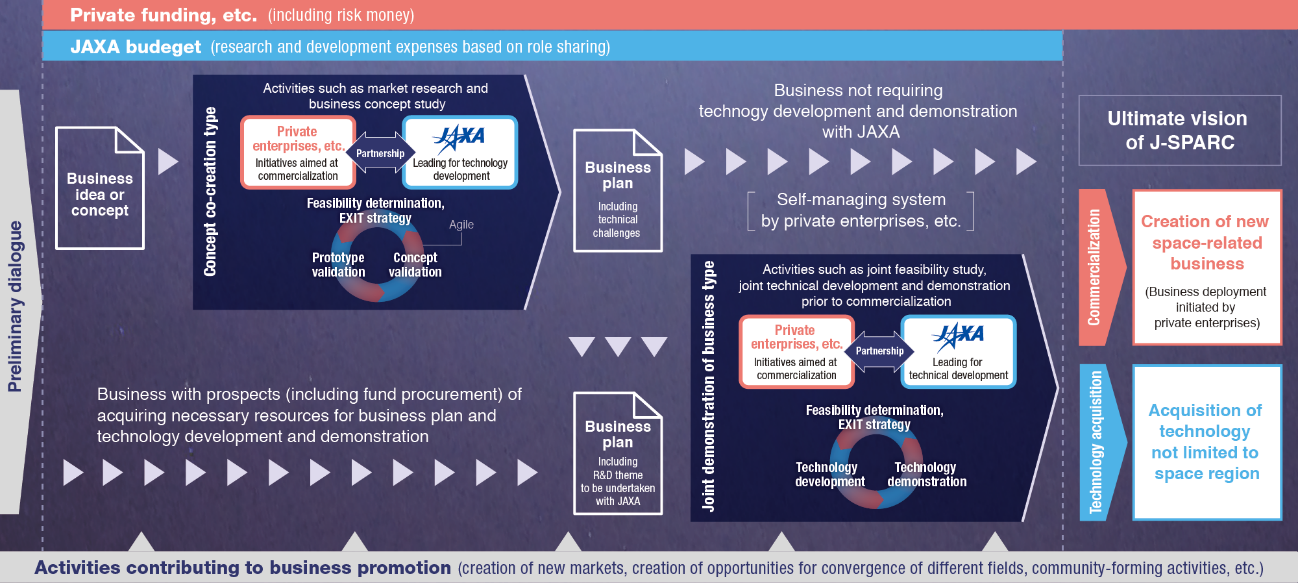
1 Features of space debris prevention device using ElectroDynamic Tether (EDT)
This device extends a tether called EDT into space and changes the orbit of the satellite using the earth’s magnetic field. It aims to deorbit the satellite after the completion of its mission (hereafter, PMD: Post Mission Disposal). This device, which is mounted onto the satellite before the launch, begins functioning after the completion of the satellite’s mission so as to lower the orbital altitude of the satellite in a short period of time, thereby causing it to reenter the earth’s atmosphere, be demised and disposed. As a result, satellites remaining in space after their mission may be reduced and generation of large quantities of debris caused by collision between satellites and space debris may be prevented.
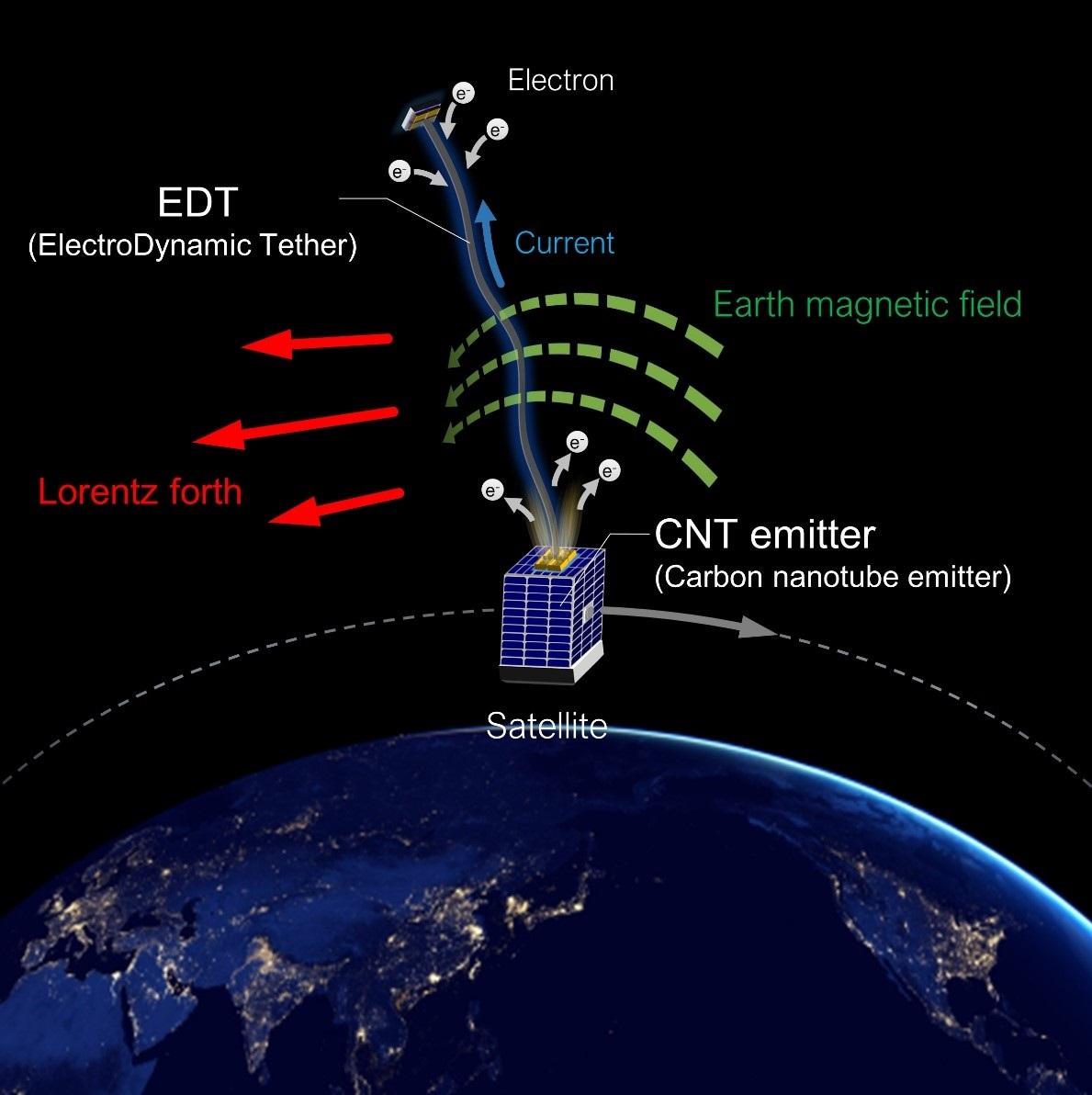
Conceptual Diagram of Space Debris Prevention Device
Using ElectroDynamic Tether (EDT)
EDT is particularly compact and lightweight in PMD technology. Because of its compact nature, it can be mounted onto nanosatellites and microsatellites which are expected to increase in the number of launches in the future. In addition, because it is lightweight, it may be introduced at relatively low cost.
Among EDT, this device, which has been jointly developed by ALE and JAXA, utilizes the earth’s magnetic field for descent from orbit. Therefore, even in the event of power failure of the satellite itself, the mounted device will function. Furthermore, by a tape-type design, the tether function has been further enhanced by utilizing not only the earth’s magnetic field but also the air resistance in space.
While at present, there are many satellites which do not have the capability to change the orbit, international standards aimed at space debris reduction are being established in recent years. Therefore, there is a possibility that future satellites that will be launched will be required to have greater PMD functions. In view of such markets and industry trends, it is expected that demand for this device will continue to increase.
2 Increase in space debris
Due to active space development in recent times and subsequent flying objects in space, it is said that space debris will self-sustaining in the near future by cascading collisions between such objects. As a result, not only will the risk of destruction of existing satellites increase, but there may also be negative impact on future satellite launches and use of satellite data.
Contributing factors to the increase in space debris include miniaturization and low cost of satellites in recent years, as well as low launching costs to low earth orbit with an altitude of 2,000km or less, making low-orbit space development the focus of much attention. In order to cut costs, low-orbit satellites are designed with lower life expectancy compared to large satellites on geostationary orbit. Thus, the launch frequency of such satellites is expected to increase in the future. In addition, because there are many satellites without the capability to change their orbit, after the completion of their mission, they remain in space until they naturally enter the earth’s atmosphere. Furthermore, some of the upper stage rocket after putting the satellite into orbit also remain in space. At minimum several years, sometimes up to several hundred years elapse until such objects reenter the earth’s atmosphere, thereby increasing the probability of objects to collide with one another.
Increasing Space Debris
On-orbit objects made public by the US by orbit monitoring data
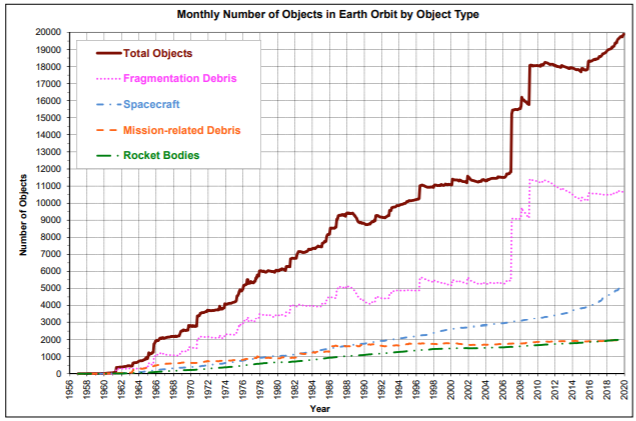
Source: The Orbital Debris Quarterly News, NASA,
January 2020, Volume 24 Issue 1
Increase in Low-orbit Satellite Launches
Number of low-orbit satellite launches
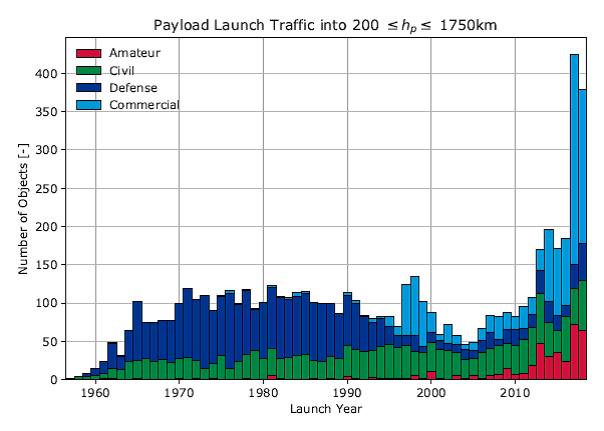
Source:ESA’s Annual Space Environment Report
ESA Space Debris Office, 17 July 2019